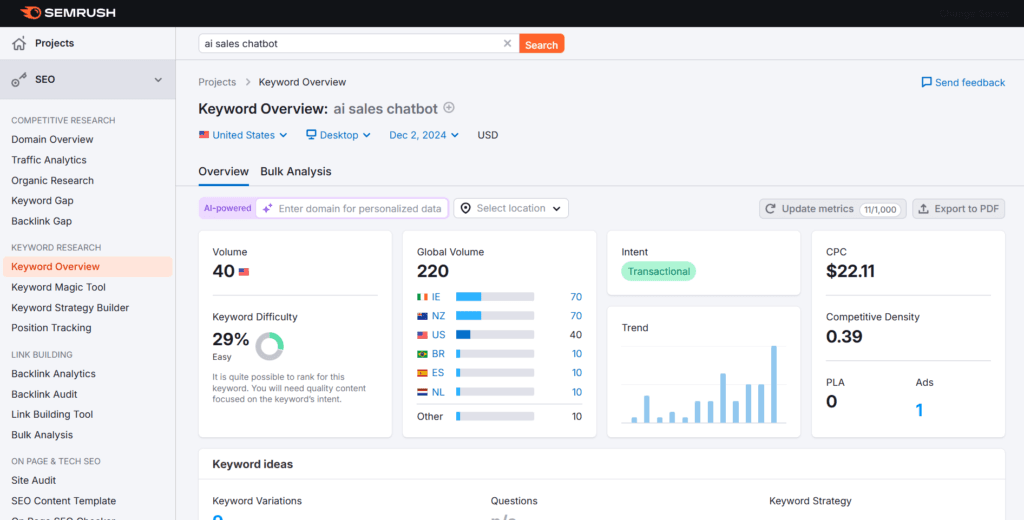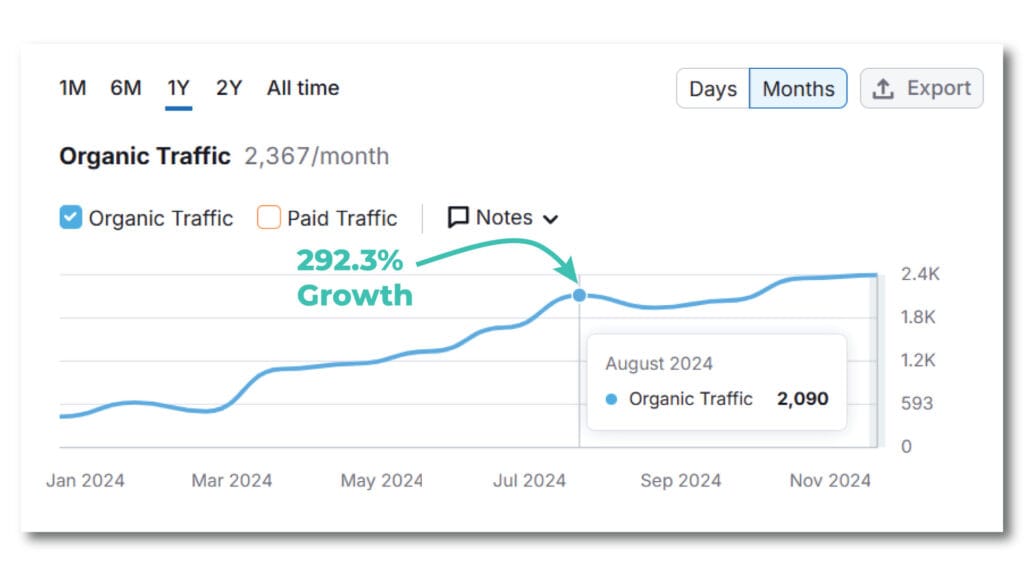Who Was My Client?
Chatsimple is a B2B SaaS startup offering advanced AI chatbot software for website sales, lead generation, and customer support. As a new business, they needed to connect with their target audience, build trust, promote their software, and increase signups. SEO-focused content marketing seemed to be an effective way to achieve these goals.
What Exactly Was the Challenge?
But Chatsimple was hardly getting any targeted organic traffic. When I started working in March 2024, they had 496 monthly organic visits.
The problem was this traffic wasn’t relevant to Chatsimple. Those website visitors would never buy Chatsimple’s software because they were not the target audience.
Chatsimple’s website ranked on the top three positions for only seven keywords, on the first page for 20 keywords, and on the top 100 positions for 1,490 keywords. All these keywords were not targeted well.
The existing blog posts lacked depth, failed to provide value to readers, and were not SEO-friendly. Most posts were AI-generated, generic, hard to read, and poorly formatted. It was a wonder some of them managed to rank and drive random visitors to the website.
What Solution Did I Suggest?
Chatsimple needed a solid content strategy, high-quality content, and strong Search Engine Optimization. That’s where I came in.
Vinay, the marketing head at Chatsimple, and I discussed the challenges they were facing and the goals they wanted to achieve. I asked him questions about Chatsimple’s products, customers, and competitors.
I took the time to fully understand their product by testing their AI chatbot software on my website and exploring all its features.
I also gained a clear idea of Chatsimple’s target audience—who they were, where they lived, the challenges they faced, and their worldviews.
I also researched their audience on platforms like Reddit, Quora, LinkedIn, YouTube, podcasts, and Semrush. My goal was to learn what they talked about, the language they used, the problems they faced, and the topics they searched for.
And to understand their competition, I went through each competitor’s websites, analyzed the performance on Semrush, and checked their social media.
After a week of research, I presented Chatsimple with a solution—a content plan.
This plan was primarily based on my keyword research. Using Semrush and Google Keyword Planner, I looked for what Chatsimple’s audience searched for on Google and their estimated search volumes.
I compiled a list of high-intent, easy-to-rank keywords relevant to Chatsimple. That means I made sure every keyword targeted their ideal audience.
For example, keywords like “best chatbot for websites,” “B2B chatbot,” “AI sales chatbot,” “disadvantages of a chatbot,” and “AI chatbot for dropshipping” are some relevant keywords for Chatsimple.

Sure, these keywords had low search volumes. But they were easy to rank and highly relevant. My focus wasn’t just on increasing traffic but on attracting high-quality visitors.
I wanted to ensure Chatsimple appeared in search results when their audience wanted to know more about chatbots. So, I knew even 1,000 targeted visits every month would be impactful.
How Did I Implement the Solution?
The strategy was ready. But the real work was just beginning—implementing it and delivering results.
The secret to content marketing is to create higher quality content than your competitors so that you rank higher and readers have no choice but to consume your content. So, I started by writing high-quality blog posts with smart on-page SEO.
Each blog post focused on a single primary keyword. I thoroughly researched each topic by reading industry publications, analyzing competitors, and studying insights from thought leaders.
The blog posts were helpful, original, and engaging (I don’t like boring walls of text). I ensured they were value-packed and in-depth, offering real solutions to readers. I included links to authoritative sources and created a robust internal linking strategy.
Most importantly, I made sure the content stood out by offering unique insights rather than repeating what had already been said.
The posts featured compelling headlines, curiosity-building introductions, and well-structured content. I also subtly promoted Chatsimple’s software with clear CTAs to create awareness and drive traffic to the product page.
My on-page SEO strategy was simple. I naturally placed keywords in areas like the meta title, meta description, headlines, subheadings, introduction, URL, image alt text, body content, and conclusion. I avoided keyword stuffing, which hurts user experience and signals Google negatively. I also used semantic keywords to help search engines better understand the content and drive more relevant traffic.
We posted consistently. Between March and July 2024, I wrote around 30 blog posts.
I also advised Chatsimple on improving their website engagement and conversions. For instance, I suggested embedding videos in blog posts to increase the average time on the page.
What Results Did I Get?
My content strategy and SEO-friendly blog posts helped Chatsimple receive relevant organic traffic and build topical authority. Here’s what I achieved for them:
- Added over 1,450 targeted, unique, organic monthly visits within 5 months. That’s 292.3% traffic growth.
- Helped Chatsimple rank in the top three positions for 30+ keywords, on the first page for 55+ keywords, and in the top 100 for 695+ keywords within the same period.
- Achieved #1 rankings for 5+ posts and first-page rankings for 17+ posts on Google.
- Secured rankings for 28 out of 30 posts on either the 1st, 2nd, or 3rd page of search results.
- Gained first-page rankings for high-intent keywords like “B2B chatbot,” “AI sales chatbot,” and “chatbot for dropshipping.”
- As of November 2024 (8 months in), my posts drive 1,700+ monthly organic visits. And it’s only increasing.

The best part is that this organic traffic continues to grow steadily every month. These results have helped Chatsimple connect with its target audience, boost brand awareness, build trust, establish authority, drive traffic to its product page, and ultimately secure more signups.

